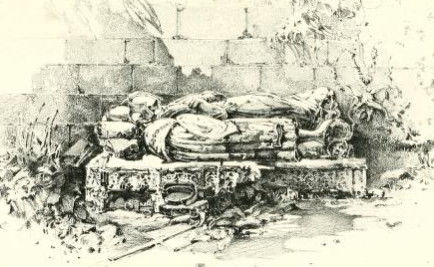Sir Herbert Maxwell, Bt.,
Public domain, via Wikimedia Commons
The Earl and Countess of Morton were buried together in the choir of the parish church of St. Nicholas Buccleuch, known as the Dalkeith Collegiate Church, in Dalkeith, south of Fife and east of Edinburgh, in Midlothian, Scotland. Known as the Morton Monument, their tombs are covered with their stone effigies, complete with their armorial bearings. The choir is now in the ruins, leaving the tombs out in the open, where, in a few centuries, the elements have erased their faces. Their hands, pressed together in prayer, were likely to have been destroyed during the Reformation. Today, as one of the visitors remarked, "[o]nce crisply carved and detailed with heraldic devices", the tombs have "the look of sand sculptures after the tide has washed in and retreated". Due to their historical value, in 2005 a team of volunteers and preservationists created a protective canopy over their effigies.



